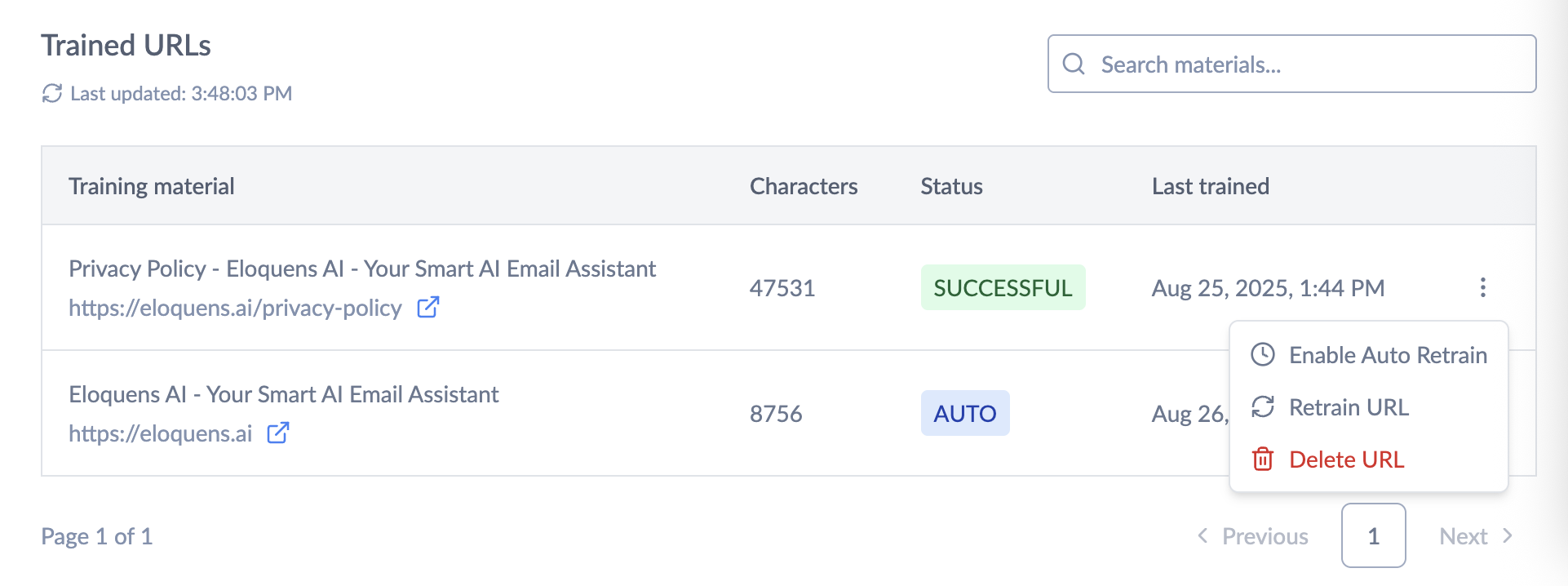Overview
Web Knowledge Auto-Retraining ensures your Eloquens AI workflows stay current with the latest content from websites that change frequently. Instead of manually retraining URLs every time content updates, you can enable automatic retraining to keep your knowledge base fresh and accurate.
What is Auto-Retraining?
Auto-retraining automatically updates the knowledge from specific web pages on a regular schedule, ensuring your AI workflows have access to the most current information. When enabled, Eloquens AI will periodically check and retrain selected URLs to capture any content changes.
When to Use Auto-Retraining
Perfect Use Cases
News and Media Sites
- Company news pages that publish daily updates
- Industry news feeds
- Press release sections
- Blog homepages with new articles
Documentation That Changes Frequently
- Product documentation with regular updates
- API documentation with version changes
- FAQ pages that get new questions
- Support knowledge bases
Dynamic Business Content
- Company announcements and updates
- Product pricing pages
- Service offerings that change seasonally
- Event pages with upcoming dates
Social Media and Community Content
- Company LinkedIn updates
- Community forum announcements
- Social media policy pages
Examples of URLs Perfect for Auto-Retraining
https://company.com/news- Company news homepagehttps://product.com/docs/api- API documentationhttps://help.company.com/faq- Frequently updated FAQhttps://company.com/pricing- Pricing that changes with promotionshttps://support.product.com/announcements- Product announcementshttps://company.com/careers- Job postings that change regularlyhttps://blog.company.com- Company blog homepage
How to Enable Auto-Retraining
Step 1: Access Your Web Knowledge
- Navigate to Knowledge Manager in your workspace
- Click the Web tab to view your web sources
- Select the web source containing the URLs you want to auto-retrain
Step 2: Enable Auto-Retrain for Specific URLs
- Find Your URL: In the training materials table, locate the specific URL you want to auto-retrain
- Open Actions Menu: Click the three dots (⋮) in the Actions column for that URL
- Enable Auto-Retrain: Select "Enable Auto Retrain" from the dropdown menu
- Confirmation: You'll see a success message and the URL status will change to "AUTO"
 Step 3: Verify Auto-Retrain Status
Step 3: Verify Auto-Retrain Status
- URLs with auto-retraining enabled show an "AUTO" status badge in blue
- The tooltip confirms "Automatic retraining enabled"
- These URLs will be automatically retrained on the system schedule
Managing Auto-Retrain Settings
Disabling Auto-Retrain
- Click the three dots (⋮) next to the URL with auto-retrain enabled
- Select "Disable Auto Retrain"
- The URL will return to manual retrain mode
Manual Retrain Override
Even with auto-retrain enabled, you can still manually retrain a URL:
- Click the three dots (⋮) next to any URL
- Select "Retrain URL" for immediate retraining
- This won't affect the auto-retrain schedule
Understanding Status Indicators
| Status |
Color |
Meaning |
|---|---|---|
| AUTO |
Blue |
Automatic retraining is enabled |
| SUCCESSFUL |
Green |
Latest training completed successfully |
| TRAINING |
Yellow |
Currently being trained |
| FAILED |
Red |
Training failed - manual retrain recommended |
| PENDING |
Gray |
Awaiting training |
Best Practices
Choose the Right URLs
✅ Good candidates for auto-retrain:
- Homepage with rotating content
- News/announcements sections
- Frequently updated documentation
- Dynamic pricing or product pages
❌ Avoid auto-retrain for:
- Static "About Us" pages
- Terms of service (changes infrequently)
- Historical archive pages
- Large directories with minimal changes
Monitor Training Status
- Check the "Last trained" column to see when URLs were last updated
- Failed auto-retrains will show in red - investigate and manually retrain if needed
- Use the refresh button to get the latest training status
Content Planning
- Enable auto-retrain before major content campaigns
- Consider seasonal content that changes predictably
- Coordinate with your content team about planned updates
Scheduling and Frequency
Auto-retraining runs on a system-wide schedule managed by Eloquens AI. URLs marked for auto-retrain are processed:
- Automatically on a regular basis (typically daily)
- Efficiently in batches to optimize performance
- Safely with error handling and retry logic
You don't need to set specific times - the system handles scheduling automatically.
Troubleshooting
Auto-Retrain Not Working
- Check Status: Verify the URL shows "AUTO" status
- Review Last Trained: Check if the "Last trained" timestamp is recent
- Manual Test: Try a manual retrain to ensure the URL is accessible
- Contact Support: If issues persist, contact Eloquens AI support
Failed Auto-Retrains
- Review Error: Check if the URL is still accessible
- Manual Retrain: Try manually retraining to identify issues
- URL Changes: Verify the URL hasn't moved or changed structure
- Disable if Needed: Temporarily disable auto-retrain for problematic URLs
Getting the Most Value
Workflow Integration
Once auto-retrain is enabled:
- Your workflows automatically get the latest content
- No manual intervention needed for content updates
- AI responses stay current with your business changes
Content Strategy
- Use auto-retrain for competitive intelligence (public competitor pages)
- Keep product information current across all customer interactions
- Ensure compliance with latest policy updates
Next Steps
- Identify Dynamic Content: Review your current web knowledge sources and identify pages that change frequently
- Enable Auto-Retrain: Start with 3-5 high-value URLs that update regularly
- Monitor Results: Check training status after a few days to ensure everything works smoothly
- Expand Gradually: Add more URLs to auto-retrain as you see the value
Douglas Ho
Comments